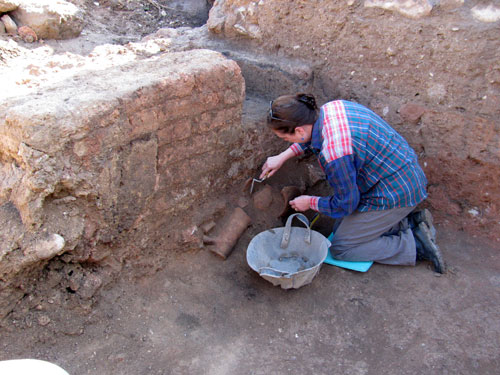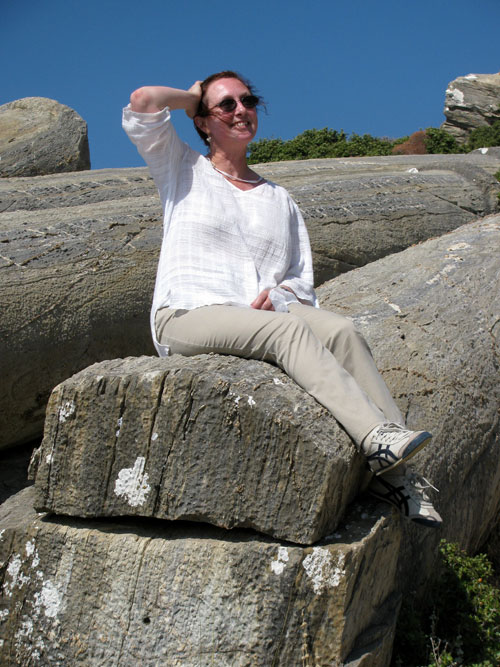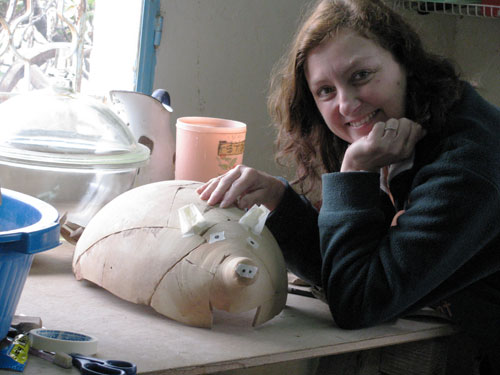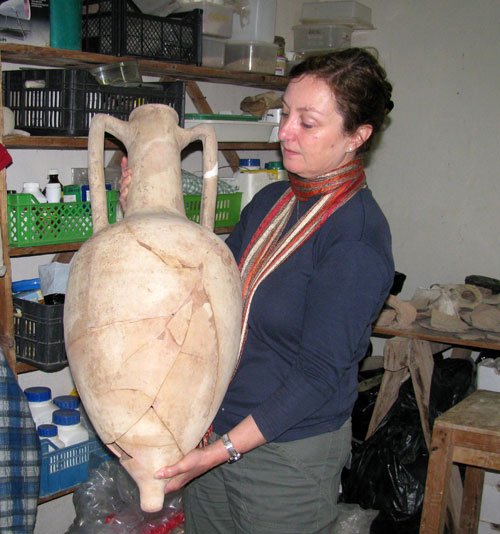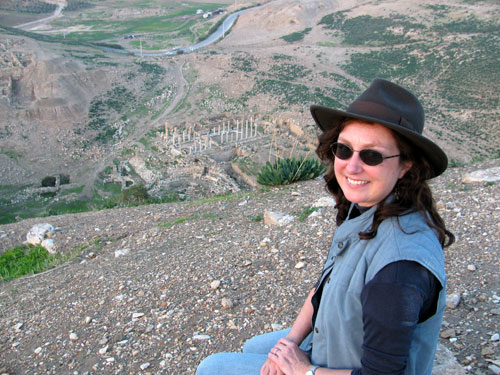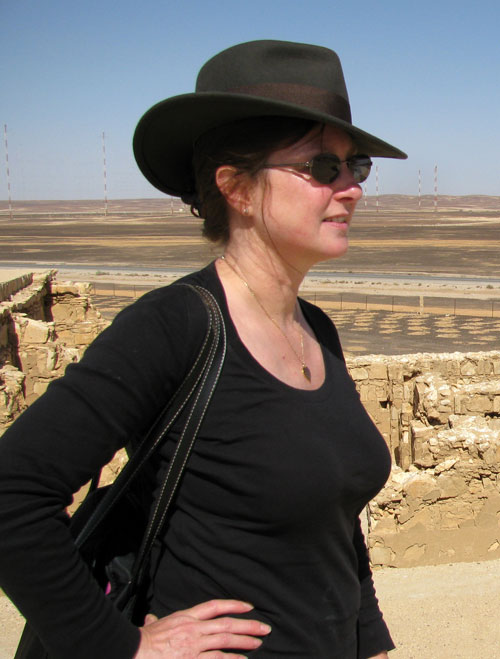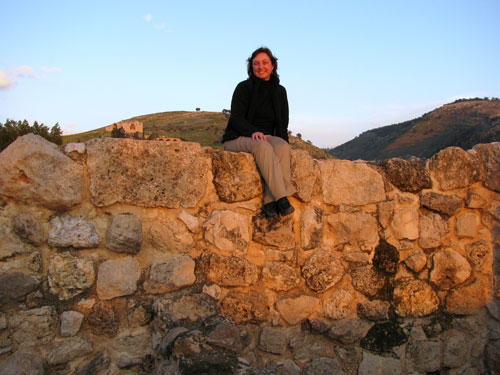Wendy Reade – Archaeologist and Conservator (aka Wendiana Jones)
Centre for Classical and Near Eastern Studies of Australia University of Sydney
Why do you think archaeology is important?
Archaeology is the detective work that uncovers our past. There’s a desire in all of us to know where we come from and therefore how we all fit together. It connects us.
If we don’t dig up the past, how will we know what it was?
If we don’t know what it was, how do we understand it and ourselves?
Without understanding the past, how do we learn from it?
Especially when literary sources are incomplete or biased or don’t exist.
When did you know you wanted to be an archaeologist, and what was it that made you want to be one?
My father says I have always wanted to be an archaeologist and there was no changing my mind! This was in response to my indignation that he had guided my siblings into safe and lucrative careers: my sister into law and my brother into medicine, while I was frustrated at the time with no apparent future in archaeology. Jobs are not easy to come by.
I think probably I first knew I wanted to be an archaeologist when my family visited Athens in 1966 and I sat on a fallen column beside the Parthenon. I was six years old and have made it my mission ever since to sit on fallen columns wherever I find them. Of course, you can’t do this on the Athenian acropolis anymore. I like to touch history. That tactile delight in the past is part of what led to my eventual career in archaeological conservation.
And now I have come full-circle, having been first inspired in Greece, I am now a member of the archaeological team to Zagora on the Greek island of Andros.
What study did you do to become an archaeologist?
To become an archaeologist I followed a bit of a wide-ranging route through a BA (Hons) in Near Eastern and Classical Archaeology (including languages) at the University of Sydney, then to a specialisation in Egyptian Archaeology through a Graduate Diploma in Ancient Documentary Studies at Macquarie University. My love of chemistry and history, the meeting of sciences and arts, led me to a Bachelor of Applied Sciences in the Conservation of Cultural Material at the University of Canberra. I found my niche here and have worked as a conservator on excavation sites ever since. I finished up with a PhD from Sydney Uni (back where I started), which combined my interest in materials science with archaeology in a dissertation on the development of the earliest glass-making in Egypt and the Near East.
In all, a total of about 15 years of study full- and part-time.
How long have you been an archaeologist?
In my heart I’ve never been anything else. I finished school at 17 in Adelaide and left home to come to the University of Sydney to study archaeology and I’ve been in and around it ever since – for about 35 years now.
What are some of the key jobs you’ve had?
Member of archaeological expeditions around the Middle East, including Bahrain, Egypt, UAE, Jordan, Syria, Turkey and now Zagora on the island of Andros in Greece.
Lecturer in materials science and analysis, and in Egyptian archaeology at the University of Sydney.
Archaeological conservation of some key objects, for example the Greek Geometric Dipylon krater, the limestone relief of Assyrian archers and for the first Egyptian mummy project (1998) in the Nicholson Museum at Sydney Uni.
Early in my twenties I worked at a desk job for a few years in a merchant bank and the stock exchange, but ran screaming from office work back to archaeology.
What skills or capabilities do you think are important to being a good archaeologist?
The skills required for being a good archaeologist or conservator include:
- observation
- passion
- problem solving
- cultural sensitivity
- being methodical
- analytical interpretation
- ability to live and work closely with colleagues
- patience
- to see things from a vast scale down to the minutiae
- manual dexterity
- some knowledge of foreign languages, such as French, German, Italian, Arabic, Greek (and any relevant ancient languages too)
What advice would you give to someone interested in this career?
If you’re interested in being rich, forget it!
If you’re interested in a rich, adventurous life with a purpose, do it!
How do archaeologists spend their time?
I would probably spend about 10 to 15% of my time working in the field on excavations and at conferences or travelling for research. The rest of my time at home is divided between the following:
doing hands-on conservation work,
sampling objects, especially glass as my particular interest, for chemical analysis and
interpretation,
being involved in the Centre for Classical and Near Eastern Archaeology of Australia,
and being Vice President of the Near Eastern Archaeology Foundation, both at the University of Sydney,
teaching and giving public lectures,
tour-leading (although recent planned tours to Egypt have been put on hold)
research,
applying for grants,
writing reports, articles and now a book,
publishing my research – a very important aspect of an archaeologist’s work
What’s it like living in the ‘dig house’ during a dig?
Each dig is different – different kinds of accommodation, different people, different set-up. For example, where I work in Jordan we live in a lovely but basic dig house incorporating a couple of old village houses. It is built around a courtyard on the top of the tell (mound) right next to the excavations. We have a cook and a washerwoman, so all I have to do is make my bed and walk a few metres to work. Heaven! I usually work from 6am until almost bedtime with breaks for meals and tea.
When I work on an excavation in north Syria, we are accommodated in two houses in a remote village. We have to fit in with the locals whose houses we share like boarders while we work and sleep there. It is often well over 40° so we end up sleeping under the stars on the roof. There are flies and scorpions and mosquitoes. We have a cook who serves our meals in an open air courtyard and we have a washerwoman, but if you don’t want your delicates to come back stiff as a board, you wash those yourself. As it is a rural community, the bore water is often diverted to the fields leaving us without running water for hours on end in the heat of the day. The diggers are taken out to the site in a minivan, while as house-staff, I work ‘at home’. Because of the heat, we have a siesta after lunch before working again until dinner time.
Zagora on Andros is different again. For the study season, we lived in modern apartments on the edge of the main town, which meant we could buy our own food and cook for ourselves or, occasionally eat out in town. There were no domestic staff so we were entirely responsible for our own washing etc. As we were working in the Andros museum on material already excavated, we would have to finish each day at 3pm when the museum shut. This left plenty of time to explore, write and relax as our accommodation was only 10 minutes walk away along pretty village streets.
Wherever we are working, we follow the local working week. In the Middle East this means that we start on Saturday and finish Thursday lunchtime. This gives us a day and a half off, sometimes going on excursions to other sites or just taking time out.
Which parts of your job do you love, like, not so much….?
Honestly, I love all of it! I love being in the field, working hands-on with objects that haven’t been touched for thousands of years, figuring them out, conserving them, working out how they were made, why and out of what, and not least, working with people who share my purpose and enthusiasm.
I like the lateral thinking challenge of preserving artefacts on site, often with limited resources. The appreciation of my co-workers is deeply satisfying when they give me a bag of fragments and I return to them a restored object.
I’m glad I am a conservator and not an excavator, as I don’t like digging much, except when I am called to a trench to remove a fragile object safely.
Overall, I am fascinated to see all the pieces come together from an excavation as we all, with our different specialisations, slowly put the jigsaw of history back together.
As a conservator, I am less happy about working in the basement of a museum or in our living quarters when they are not located on site – I feel too removed from the action in the trenches. The up side is that I am a lot more comfortable and clean than those in the trenches!
The greatest aggravation is when the political instability of a country prevents us sometimes from working in the field. It can be years before we are able to return.
How do you and your family cope with separation during archaeological digs?
I have two children and while they were young I limited my time away on digs, but now that they are older, I can be away a little longer or more often. Some archaeologists bring their families with them on excavations.
What’s been your worst experience in archaeology?
My worst experience in archaeology was having a severely arthritic foot that almost crippled me until surgery remedied that a couple of years ago (it was from a sporting injury not archaeological work). I hobbled over rough ground on site with a hiking pole and in a lot of pain. I was afraid I might not be able to continue working on excavations or even to travel.
What’s been your best experience in archaeology?
I couldn’t name one experience as my best. Apart from the work, I love the amazing places I get to see and live in for a while and the wonderful local people I meet along the way. I have the chance to get to know peoples and places in a way that tourists can’t. One of the main delights of my job is the people I work with who share my passion and a lot of laughs.
On site I love the simplicity of life, the food, not having tv, radio or newspapers, and until recently, mobile phones. It is great not having to drive to work, pay bills or answer emails. Often there is no internet.
I enjoy seeing artefacts I have conserved on display in museums and the appreciation for my work that my colleagues show.
One of the best things of all was when I went to Disneyland in LA a couple of years ago. I bought an Indiana Jones hat – real wool felt and a great fit. It folds up in my luggage and I wear it on site to general amusement and approval. It seems apt, as I have friends who call me ‘Wendiana’.
What’s your realistic and/or dream hope of archaeological achievement?
My aims for my future in archaeology are just to keep working on excavations, to keep contributing to piecing together our history and to keep conserving and publishing. Long live the Indi hat and the new foot!
What are some words you would use to describe your experiences as an archaeologist?
Fascination, anticipation, discovery, challenge, enrichment, happiness

